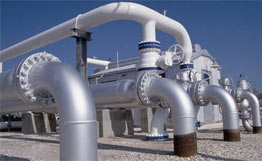
WESTERN MAJORS SIGN AGREEMENT OF INTENT ON TRANS-CASPIAN OIL TRANSPORT SYSTEM
Publication: Eurasia Daily Monitor Volume: 4 Issue: 18
By:

As anticipated some time ago (see EDM, August 17, 2005, March 16, 2006), Moscow’s extortion of Western companies in the Caspian Pipeline Consortium (CPC) on Russian territory has finally persuaded the companies to choose a trans-Caspian solution for the export of their rapidly growing oil output in Kazakhstan. The trans-Caspian solution is also the optimal one for the future output from Kazakhstan’s super-giant offshore Kashagan field.
On January 24 in Astana, a Memorandum of Understanding to create a trans-Caspian oil transport system was signed by the participant companies in the TengizChevroil consortium, those in the KCO consortium, and Kazakhstan’s national oil and gas company KazMunayGaz (Interfax, January 24)
TengizChevroil consists of the American companies ChevronTexaco and ExxonMobil, KazMunayGaz, and the Russian-American LukoilArco, with stakes of 50%, 25%, 20%, and 5%, respectively. The consortium is developing the giant onshore field Tengiz, richest oilfield in operation in Kazakhstan. The KCO consortium includes Italy’s Eni-Agip, Total of France, ExxonMobil, and Royal-Dutch Shell, each with an 18.5% stake, ConocoPhillips of the United States with 9.25%, and KazMunayGaz and the Japanese-based Inpex with 8.33% each. This consortium is developing the offshore Kashagan and adjacent oilfields, the first production from which is due by 2010-2011.
Many of these producer companies are also members of the Moscow-pressured CPC transport consortium, to wit: KazMunayGaz, Chevron, Lukarco, Shell (through Rosneft-Shell), Mobil, and Agip, with stakes of 19%, 15%, 12.5%, 7.5%, 7.5%, and 2%, respectively. The Russian government with 24% is the single largest shareholder in the CPC pipeline, which runs to Russia’s Black Sea port of Novorossiysk, annually carrying approximately one half of the total oil exports from Kazakhstan. With all the other pipelines out of Kazakhstan running also to Russia, the Western companies have evidently, if belatedly, concluded that they need alternative transit routes.
The January 24 agreement envisages a shuttle system of sea tankers to carry oil from Kazakhstan to Azerbaijan and into the Baku-Tbilisi-Ceyhan (Turkey) pipeline. The tanker system’s capacity is projected at 25 million tons per year in the first stage and 38 million tons in the second stage. The oil port on the Kazakh side will be built in Kuryk, in preference to the initially chosen Aktau. The Kuryk Bay provides a natural shelter that makes possible uninterrupted operations in winter and during storms. Meanwhile, the port of Aktau (which also handles dry cargos) is already being used to the limits of its design capacity.
The transport system’s cost is estimated at $3 billion. The port and tanker line will be primarily dedicated to the production from Tengiz and Kashagan with the adjacent oilfields.
Presenting the signed Memorandum, KazMunayGaz General Director Kairgeldy Kabyldin confirmed that Russia was posing unacceptable conditions for the planned expansion of the CPC pipeline, thus making it necessary for the companies to launch the trans-Caspian transport system for their growing oil output. However, Kabyldin — and, the previous week, Energy and Natural Resources Minister Baktikhoja Izmuhambetov — noted that negotiations would continue with the Russian government over that pipeline’s expansion.
In a move clearly meant to pressure Western investors, the Russian government’s inter-agency group on the CPC pipeline omitted the issue of expanding the pipeline from the group’s annual report, just forwarded to the Russian president and prime minister. By the Russian group’s controversial accounting, the CPC consortium — that is, basically the Western companies — is currently $5 billion in the red.
The CPC pipeline carried 31 million tons of oil from Kazakhstan in 2006, surpassing the line’s first-phase capacity of 27 million tons, though still less than one half of the line’s planned second-phase capacity of 67 million tons.
Moscow’s onerous terms on CPC’s Western shareholders, and consequent uncertainty over the export outlets, had become a factor in delaying the production schedule at Tengiz and start of production at Kashagan. According to data just released by TengizChevroil, its production declined from 13.6 million tons in 2005 to 13.3 million tons in 2006, instead of the planned second-phase production ramp-up. At Kashagan, the first commercial production (“early oil”) will come on stream two years after the initially anticipated 2008-2009.
The January 24 Memorandum of Understanding is a milestone along a negotiating process that dates back to the Clinton Administration’s 1998 initiative for the East-West Energy Transport Corridor, a centerpiece of which was the planned Aktau-Baku-Tbilisi-Ceyhan oil export route. The process received strong impetus last year with the commissioning of that pipeline and the signing of an interstate agreement by Presidents Ilham Aliyev of Azerbaijan (a leading proponent of the project) and Nursultan Nazarbayev of Kazakhstan to create a trans-Caspian oil transport system (see EDM, June 2, 19, 21, 2006, January 23, 2006).
The memorandum now signed by the companies should be understood as an irreversible decision to proceed with creating this system, and not as a negotiating tactic vis-à-vis Moscow regarding the terms of using the CPC pipeline. Moscow’s terms will never improve if Russia retains its overwhelming sway over the transit of oil from Kazakhstan.




